
Introduction
A menopause weight loss plan works best when it emphasizes protein, fiber, and balanced calories. Many women find that aiming for a moderate calorie intake (often 1,500–1,800 calories/day) supports weight loss, though individual needs vary depending on height, weight, activity level, and metabolism. Most benefit from 20–30 grams of protein per meal and 25–30 grams of fiber per day to help preserve muscle and curb hunger. Research shows that combining nutrition adjustments with strength training and regular physical activity leads to more sustainable results during menopause [BMS, 2023].
Key Takeaways
- Protein + fiber are the foundation of a menopause diet plan for weight loss.
- A safe calorie range is 1,500–1,800 daily, not an extreme restriction.
- Focus on Mediterranean-style eating: whole grains, legumes, fish, olive oil.
- Limit sugar, refined carbs, and ultra-processed foods to reduce belly fat.
- Pair diet with strength training, aerobic exercises, sleep, and stress control for the best results.
Why Weight Loss After 40 Changes During Menopause
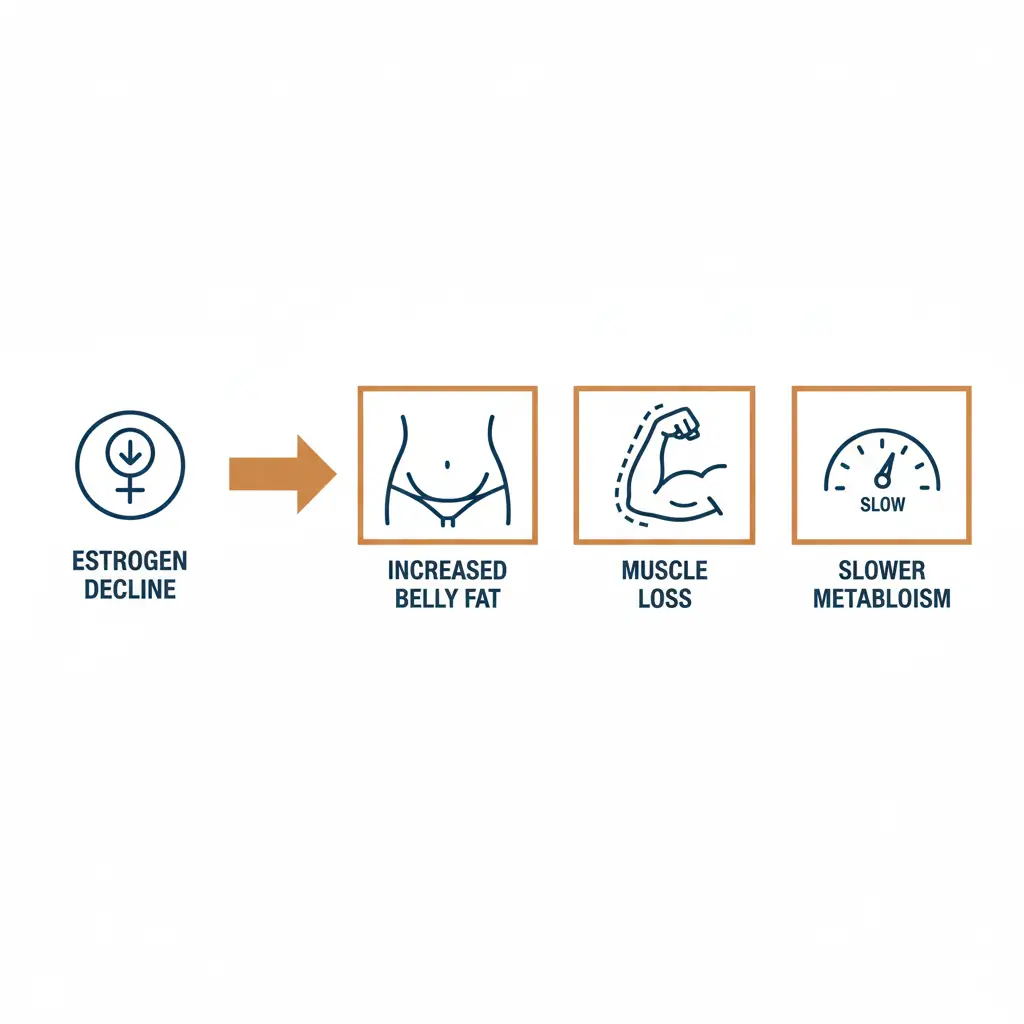
Hormonal Shifts — Estrogen, Insulin, Cortisol
When estrogen declines, your body’s fat distribution changes. Fat that once sat in your hips and thighs often shifts to the abdomen, creating the classic menopause belly. At the same time, declining estrogen increases insulin resistance, meaning your body struggles to process carbs as efficiently. Add stress into the mix, and rising cortisol levels promote fat storage in the midsection even further. Learn more about the connection in our guide on hormonal weight gain after 40.
Metabolism Slowdown and Daily Calorie Needs
After 40, your metabolism naturally slows. Studies estimate women burn about 150–250 fewer calories per day compared to their younger years. That’s like an extra snack sitting in your system each day. If you don’t adjust calorie intake or activity, the scale creeps upward—sometimes without you realizing why. For a deeper breakdown, see our post on calorie needs for women after 40.
Muscle Loss and Body Composition Changes
Menopause also accelerates sarcopenia—age-related muscle loss. These shifts in body composition—less muscle, more fat—make weight management harder unless diet and exercise are adapted. Muscle is metabolically active tissue; the more you have, the more calories you burn at rest. Losing it means your body burns fewer calories naturally, even if you eat the same amount. That’s why protein and resistance exercises become non-negotiable after 40.
Lifestyle Factors — Stress, Sleep, Activity
Night sweats and hot flashes aren’t just annoying—they disrupt sleep. Poor sleep affects ghrelin and leptin, the hormones that regulate hunger and fullness, leaving you hungrier and less satisfied. Stress eating often follows, compounding weight gain. Better diet, sleep, and stress management directly improve quality of life, reducing fatigue, cravings, and mood swings. Read our related post on confidence building after 40 to see how mindset helps support long-term health.
Step-by-Step Menopause Diet Plan
Step 1 — Set Realistic Calories (1,500–1,800 kcal/day)
Forget crash diets. Eating 1,200 calories or less may seem tempting, but it slows metabolism and causes muscle loss. Most women do best at 1,500–1,800 calories/day, depending on activity level. That’s enough to create a 300–500 calorie deficit for gradual, safe weight loss without feeling deprived.
Step 2 — Prioritize protein (20–30 g per meal)
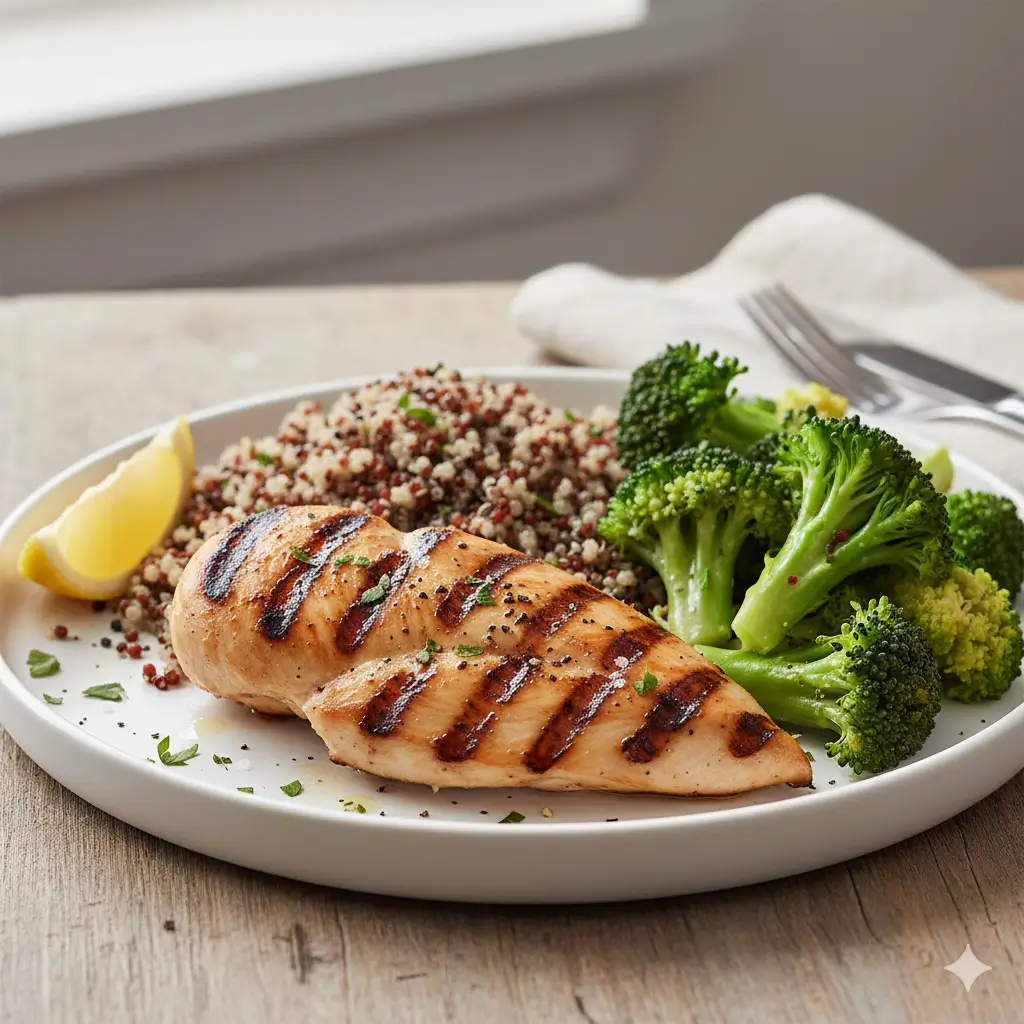
Protein is your best ally. For older adults, including women in menopause, protein becomes even more important to protect lean mass and metabolism. Aim for 20–30 grams per meal to preserve muscle, balance blood sugar, and curb cravings.
- Good sources: chicken, fish, tofu, lentils, Greek yogurt, eggs.
- Tip: Protein supports both fat loss and muscle gain, especially when combined with strength training. For exact recommendations, check our full guide on protein intake for weight loss after 40.
Step 3 — Eat More Fiber (25–30 g/day)
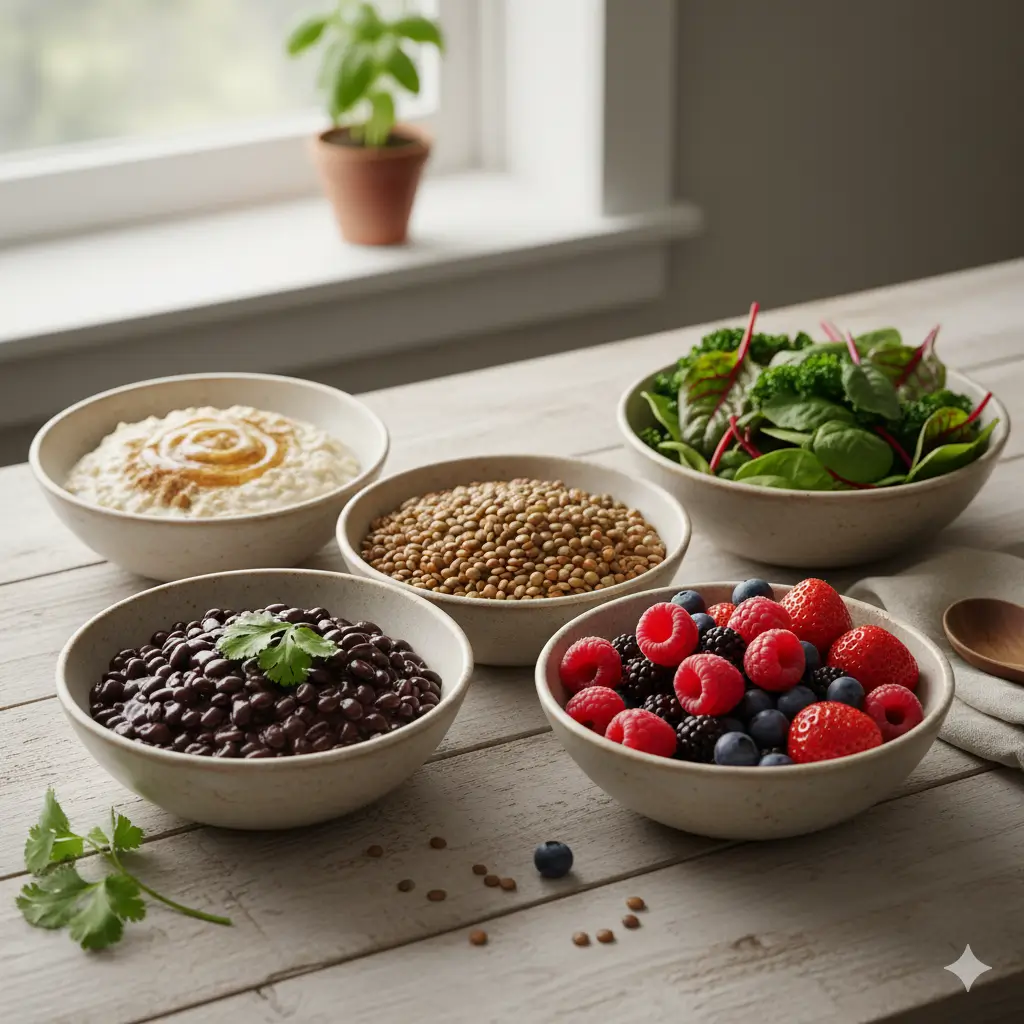
Fiber stabilizes blood sugar and curbs cravings. Focusing on fruits and vegetables, along with legumes and whole grains, maximizes fiber intake and nutrient density.
- Sources: beans, chickpeas, oats, quinoa, cruciferous vegetables, berries.
- Example: Swap white rice for quinoa and chips for roasted chickpeas.
- A balanced meal plan rich in fiber also delivers lasting health benefits, from improved digestion to lower cholesterol. For a complete overview, see our diet and nutrition for women over 40.
Step 4 — Choose Healthy Fats & Phytoestrogens
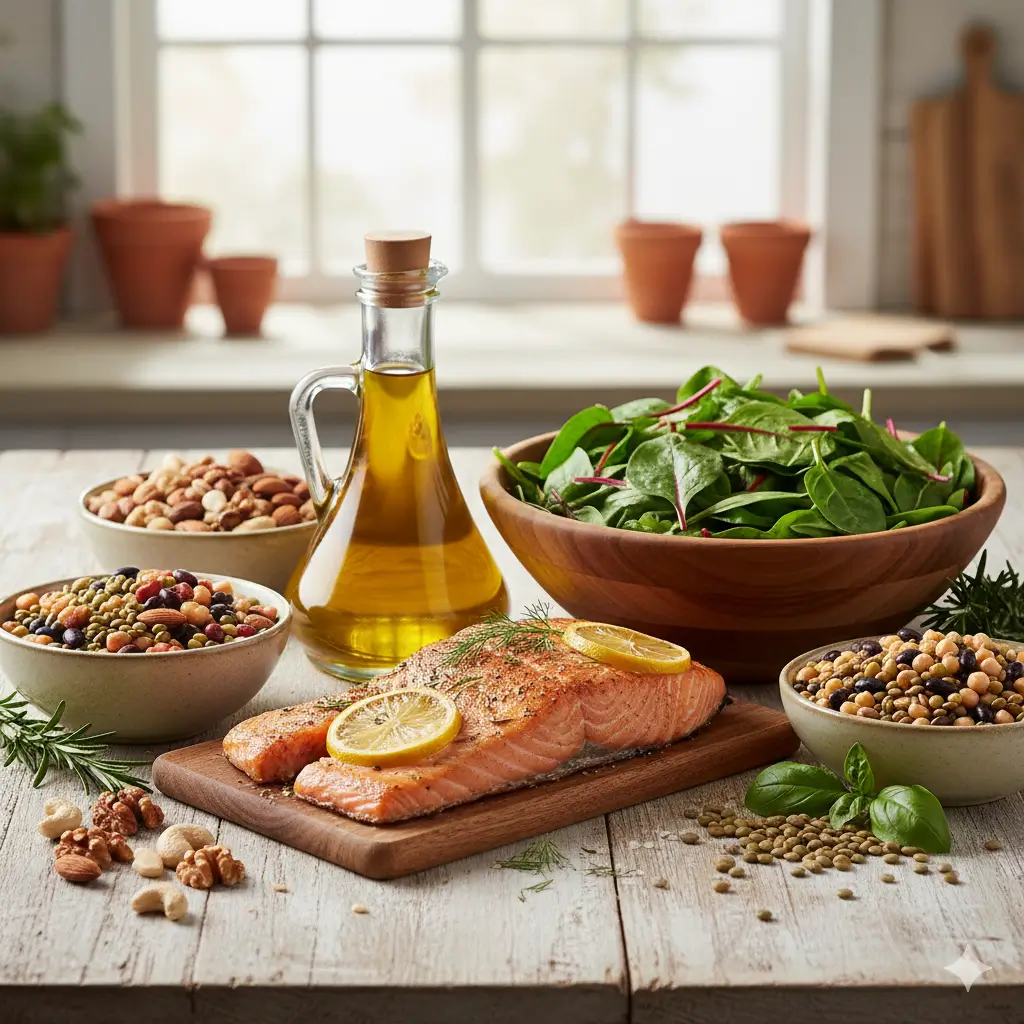
Healthy fats reduce inflammation and support heart health, which is especially important since cardiovascular risk rises after menopause. Phytoestrogens (plant estrogens) may also help ease hot flashes.
- Healthy fats: olive oil, avocado, nuts, salmon.
- Phytoestrogen foods: soy, flaxseed, lentils, chickpeas.
- In contrast, too many saturated fats increase the risk of heart disease and weight gain. The Mediterranean diet, rich in fish, olive oil, and legumes, is one of the most studied eating patterns for midlife women. This eating pattern is strongly linked to improved heart health.
Step 5 — Limit Refined Carbs, Sugar & Alcohol
White bread, pastries, soda, and alcohol spike blood sugar and increase belly fat storage. You don’t need to eliminate carbs—just swap them for whole grains and legumes. Save treats for special occasions instead of daily habits.
Step 6 — Hydration & Meal Planning
Dehydration can mimic hunger. Drink 2–3 liters of water daily, and start meals with water or herbal tea. Plan meals in advance—batch cook proteins, chop vegetables, and keep healthy snacks visible. This reduces decision fatigue and late-night cravings. Consistent prep also encourages healthier eating patterns long-term.
Step 7 — Pair Diet with Lifestyle Changes

- Strength training: 2–3 sessions/week with dumbbells, bands, or bodyweight. Include resistance exercises like squats, push-ups, and dumbbell lifts. Aim to work each major muscle group—legs, core, back, and arms—at least twice per week.
- Walking/cardio: Aim for 8–10k steps/day or 150 minutes weekly. Incorporating aerobic exercises like brisk walking, cycling, or swimming supports fat loss and endurance.
- Stress management: Yoga, deep breathing, or journaling.
- Sleep: Aim for 7–9 hours with a consistent bedtime routine.
- If you’re just starting, explore our strength training workouts for women over 40 to build a safe, effective routine.
Example Menopause-Friendly 1-Day Meal Plan
Here’s a practical meal plan tailored for weight loss during menopause:
| Meal | Example | Nutrition Focus |
|---|---|---|
| Breakfast | Greek yogurt with flaxseed and blueberries | Protein + phytoestrogens + antioxidants |
| Lunch | Grilled salmon with quinoa and steamed broccoli | Omega-3 + lean protein + fiber |
| Snack | Apple slices with almonds | Fiber + healthy fats |
| Dinner | Lentil soup with leafy greens and olive oil drizzle | Plant protein + phytoestrogens |
| Evening | Herbal tea + 1 square dark chocolate | Stress relief + mindful treat |
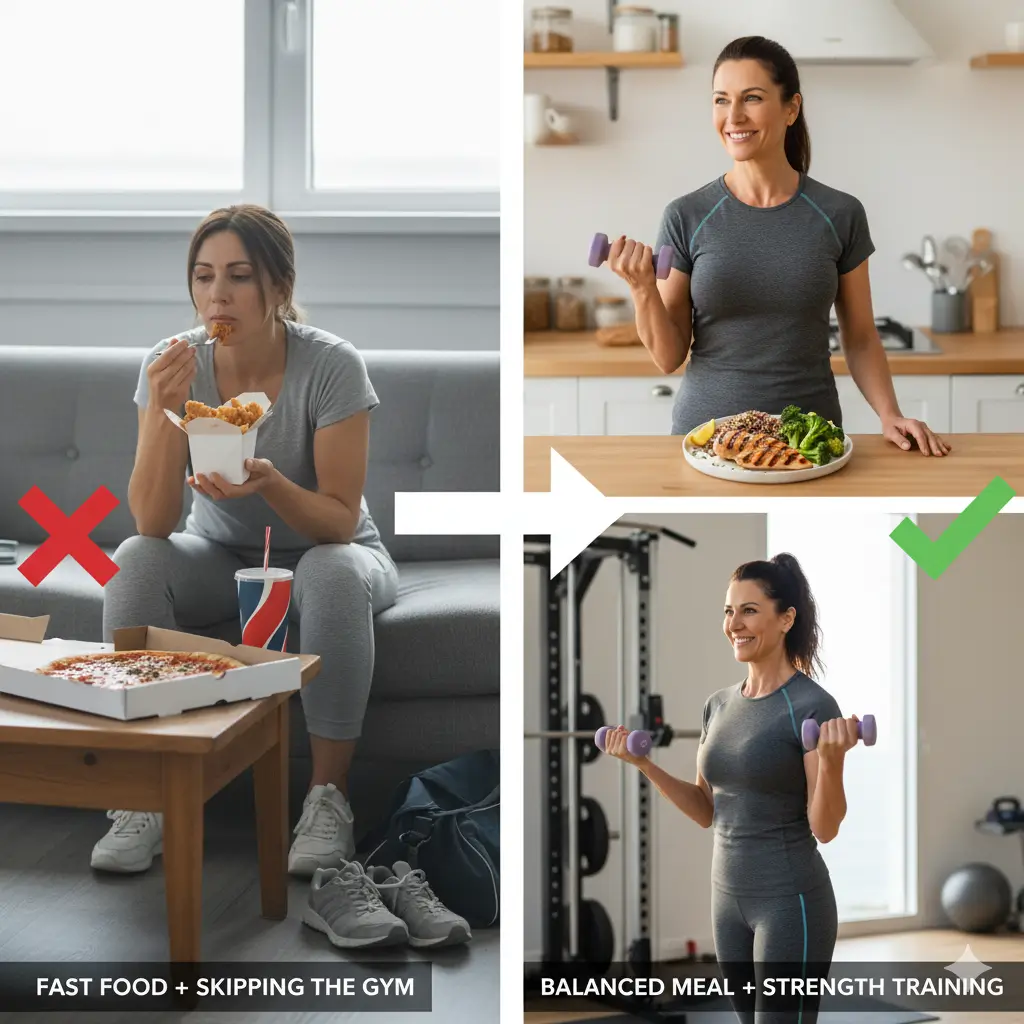
Common Mistakes and Fixes
- ❌ Eating too little (1,200 calories) → ✅ Aim for 1,500–1,800 for sustainable fat loss.
- ❌ Skipping protein → ✅ Include protein at every meal.
- ❌ Depending only on supplements → ✅ Use food as the foundation, supplements as support.
- ❌ Cutting all carbs → ✅ Focus on whole grains and legumes.
- ❌ Skipping exercise → ✅ Resistance training + aerobic exercises = winning combo.
Menopause Diet Plan for Weight Loss: FAQs
Quick fixes rarely work. The safest approach is a moderate calorie deficit (300–500/day), paired with strength training and a protein-rich diet. Expect 0.5–1 pound per week—steady, sustainable progress.
For most, no. One thousand two hundred calories slows metabolism and increases fatigue. A safer range is 1,500–1,800 calories/day for many women, though exact needs depend on body size, activity, and health status.
Yes, but it takes time. Research shows that strength training, diet, and stress management together reduce abdominal fat. Spot reduction doesn’t work, but overall fat loss plus muscle gain will slim your waist.
Refined carbs, sugary drinks, fried foods, processed snacks, and excess alcohol. These drive insulin spikes and contribute to fat gain, especially around the abdomen.
Supplements can support but not replace diet. Helpful ones may include vitamin D, calcium, and omega-3s, while phytoestrogens (like soy or flaxseed) may help some women but not all. Always consult a healthcare provider before starting supplements, especially phytoestrogens or high-dose omega-3, due to possible medication interactions.
Evidence
There are multiple studies showing how protein, walking, and Mediterranean-style diets benefit women in menopause.
| Claim | Source |
|---|---|
| Protein preserves lean mass during menopause | NIH |
| Brisk walking and aerobic exercise have been shown to reduce visceral fat and waist circumference over time. | Harvard Health |
| Mediterranean diet lowers weight & heart risk | Mayo Clinic |

Conclusion
Managing weight during menopause is challenging, but it’s not impossible. By combining balanced meals, protein, fiber, and lifestyle changes, you can take back control of your health. Improving eating habits now not only supports weight management but also strengthens long-term overall health and confidence. Ready to dive deeper? Start with our diet and nutrition hub for women over 40 and explore step-by-step strategies that make weight loss sustainable.
Author
Written by: Victoria David — Founder & Midlife Wellness Educator
Certificated Holistic Health & Wellness Coach.
Last updated: 2025-09-28 (CET)